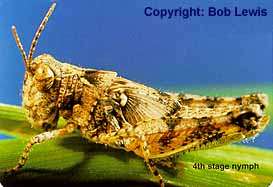Nymph description 5 of 15

Distribution

Nymph Description: Colour can be from light green to dark brown. The thorax tends to have a visible, though not always full, 'X' mark as seen from above. The rear femur can have a one (A. pusilla) to two dark bands at a 90 degree or skewed angle. Rear shanks can be banded or not. The antennae of most species are short, from the side about one to one and a half times the upright length of the eye. These species do not form bands.
Confusion with Australian plague locust and A. cruciata: When not in bands most species are similar in shape, colour and sometimes size (compare photos).
Unique features: As a group, only the mostly present 'X' mark on the thorax and short antennae combination. Most are shorter and stouter than a plague locust nymph if compared in the hand and lack a light band at the top of the rear tibia. The antennae of plague locust nymphs tends to be about twice the upright length of the eye when viewed from the side. A cruciata can be difficult to tell apart from all other species in the same genus unless it is in bands or unless you are outside the small range of A. cruciata. In early stages the hind tibia of A. cruciata is unique by being completely dark.
Further information on this species: Description of adult
